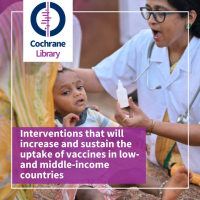
What is the aim of this review?
The aim of this Cochrane Review was to evaluate the effect of different strategies to increase the number of children in low- and middle-income countries who are vaccinated to prevent infection by a disease. Researchers in Cochrane collected and analysed all relevant studies to answer this question and found 41 relevant studies.
What are the main results of the review?
The review authors found 41 relevant studies from Afghanistan, China, Côte d'Ivoire, Ethiopia, Georgia, Ghana, Guatemala, Honduras, India, Indonesia, Kenya, Mali, Mexico, Nepal, Nicaragua, Nigeria, Pakistan, Rwanda, and Zimbabwe. These studies included 100,747 participants. They compared people receiving these strategies to people who only received the usual healthcare services. The studies showed the following.
- Immunisation outreach alone or in combination with non-monetary incentives or health education probably improves full vaccination uptake among children under five years of age.
- Health education may lead to more children receiving three doses of diphtheria-tetanus-pertussis containing vaccine (DTP3).
- The use of specially designed immunisation cards may improve the uptake of DTP3.
- Using phone call or text messages to remind caregivers about vaccination may have little or no effect on improving uptake of DTP3.
- Involvement of community leaders in combination with health provider intervention probably improves uptake of DTP3.
- We are uncertain if training of health providers on interpersonal communication skills improves the uptake of DTP3.
Authors: Oyo-Ita A, Oduwole O, Arikpo D, Effa EE, Esu EB, Balakrishna Y, Chibuzor MT, Oringanje CM, Nwachukwu CE, Wiysonge CS, Meremikwu MM
